
…by Holly Putnam Bacasa, PT
Your baby’s motor skills are connected to every area of their development! Getting your BABY MOVIN’ is their first step towards exploring, socializing, helping to care for themselves, and communicating. Read on to learn how your BABY MOVIN’ integrates with all of the components of early development. As a pediatric Physical Therapist and Early Intervention evaluator, I am so excited to have this opportunity to help you see why you want to get your BABY MOVIN’!
Let’s Get Your Baby Movin’!
So every parent wants their baby to move–to gain control of their head, to find their hands and feet, to roll, sit, crawl and walk, etc. right? OF COURSE YOU DO!
But did you ever ask yourself why? That seems like a silly question, huh? You should see the look in the parents’ eyes when we have to ask that question when they help write an objective for their child. Of course they know the answer, they just never had to articulate it. THERE ARE SO MANY REASONS WHY, of course!
Your baby’s ability to move is connected to every other area of their development.
When early intervention therapists assess developmental skills, they assess five areas, including self- care skills, personal-social skills, communication skills, gross & fine motor skills and cognitive skills. Yes- all of these areas can be scored on a baby even less than one month old!
Remember that your baby is amazing and they already can do amazing things as soon as they are born!
BABY MOVIN’ & SELF-CARE SKILLS
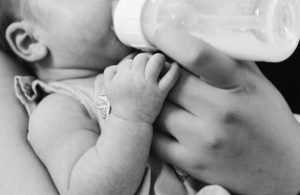 At first, your baby’s movement and tolerance to movement is important to help them participate with one of the first self-care skills of eating. Just think of all the movement involved! Do they tolerate being in different positions for nursing or when bottle fed? Is their mouth strong enough to form a seal when nursing or bottle fed? Are they starting to touch or support the bottle, grasp your finger or move their hands on the breast when being nursed?
At first, your baby’s movement and tolerance to movement is important to help them participate with one of the first self-care skills of eating. Just think of all the movement involved! Do they tolerate being in different positions for nursing or when bottle fed? Is their mouth strong enough to form a seal when nursing or bottle fed? Are they starting to touch or support the bottle, grasp your finger or move their hands on the breast when being nursed?
 Are they able to move their tongue to the sides of their mouth to help with chewing and swallowing? Do they have enough control of the neck and trunk muscles to sit up for safe eating? Do they have control of their hands to pick up small pieces of food to feed themselves?
Are they able to move their tongue to the sides of their mouth to help with chewing and swallowing? Do they have enough control of the neck and trunk muscles to sit up for safe eating? Do they have control of their hands to pick up small pieces of food to feed themselves?

Also, their eventual ability to move more will help them participate in other routine activities during your day.
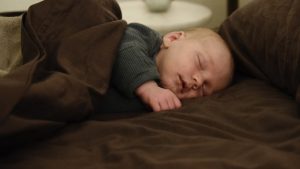
Their ability to change positions on their own more may help them sleep better. Their movement will let them turn their head on their own, use their hands for self soothing and eventually roll to their sides.
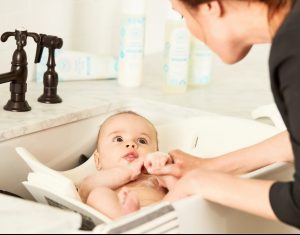
They will also learn to move to help more with self-feeding, drinking and dressing. They can relax their body at bathtime or learn to become Master Splashers! Maybe even they will eventually help clean up their toys!
This is a lot of work to learn all of this stuff, and right now it’s their job- and it’s our job to help guide them!
BABY MOVIN’ & PERSONAL SOCIAL SKILLS

Your baby’s tolerance to being held, being moved into new positions and learning to move are all important for calming, comfort, care and bonding. Their ability to move their eyes helps them find you- their favorite person- and make eye contact! (Let’s not forget that eye movement is controlled by muscles.) They also may find a way to use their hands to soothe themselves.
 They can move their arms and legs as a way to communicate and express their emotions before they can talk. They may have quick, excited actions when happy, and they may stiffen their body when something doesn’t feel good or they are frustrated or mad.
They can move their arms and legs as a way to communicate and express their emotions before they can talk. They may have quick, excited actions when happy, and they may stiffen their body when something doesn’t feel good or they are frustrated or mad.
 As you get to know your baby’s personality, they will add to their list of things they like and don’t like, like certain toys, positions they play in, places they go, etc . They also begin to recognize familiar and unfamiliar people, develop some stranger awareness and are likely to become their older brother or sister’s biggest fan and will love any attention from them they can get!
As you get to know your baby’s personality, they will add to their list of things they like and don’t like, like certain toys, positions they play in, places they go, etc . They also begin to recognize familiar and unfamiliar people, develop some stranger awareness and are likely to become their older brother or sister’s biggest fan and will love any attention from them they can get!
Knowing their favorite things and favorite people are are great way to motivate them to MOVE!
 They begin to discover their own selves as they begin to notice and look at their hands (their hands begin to move and explore closer to face), and their hands begin to grab their raised feet. It is common to see your baby find their hands, by looking at them, around 3 months and finding their feet around 5 months.
They begin to discover their own selves as they begin to notice and look at their hands (their hands begin to move and explore closer to face), and their hands begin to grab their raised feet. It is common to see your baby find their hands, by looking at them, around 3 months and finding their feet around 5 months.
Then watch out! At 6 months, your baby’s has mastered reaching and is fascinated with anything in their reach. This is when your hair gets pulled back, wearing jewelry is risky and the dodging begins to keep your glasses on! It’s all good!
BABY MOVIN’ & COMMUNICATION SKILLS
 Is your baby “talking”?
Is your baby “talking”?
I’m not a speech therapist, but I try to learn as much from my speech therapy friends as I can…. and I do know that their mouth, lips and/or tongue need to move and their lungs need some power to do their first “talking”- crying, cooing, grunting, squealing, laughing and eventually using vowels and consonants in babble. What I do know from my experience and training is that making sounds, babbling and talking all require breath support, so that eventually your baby will not only be louder, they will also string more sounds and words together when they talk. Breath support increases as your baby’s core strength improves.
Baby will express their emotions with their sounds and facial expressions. They will also move their arms and legs to tell you they are happy or excited. They may also stiffen their legs or arch their backs when they are uncomfortable, frustrated or mad.
Have you heard the phrase, “You can’t talk before you walk”? I do honestly believe it has some meaning, though I will also agree that it is not completely true. Every baby is different! It’s especially not true in the late walkers or content sitters who capitalize on their floor time and focus instead on mastering their voice. Sitting and walking with good dynamic balance is the ultimate sign of core strength, in my opinion. So once your baby can do this, then the sounds, babble and eventual talking will come.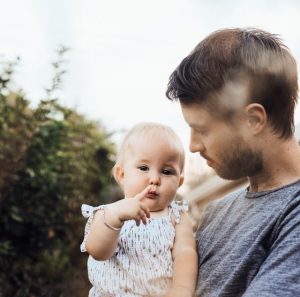
An additional school of thought among us early intervention therapists, is that it is too much for a child to learn to walk and talk at the same time. Of course this is not always the case- every child is different! But in my work, parents often report that their child used to “talk” a lot more before they started to walk, and now they don’t hear much “talking” at all.
No worries! We like to say that they put their talking on the “back burner.” They are focusing on their new skill and having fun!
 Is your baby hearing/listening/understanding?
Is your baby hearing/listening/understanding?
Your new baby should be using their movement to respond to sounds. You may see a sound kick in the startle reflex. You may see your baby open their eyes wider when they hear a new sound. They eventually will turn their eyes and head equally to the right and left to seek out that sound. They will smile and move their arms and legs to show their excitement when you talked to them in your “high pitched happy tone”.

Next they will literally take everything to the next level by eventually finding their way (rolling, bum scooting, crawling, walking) to get from point A to B, and you will find that this is a time that you are using more and new words with them. As they are now moving more, you are using words for safety or excitement (maybe changing your voice tone), you are using more directional words (prepositions), and you will find yourself labeling more people and things in the room as they move and play.
So even though you may not be hearing your baby talk as much as they once did, remember that they are now working hard to listen and understand what you are saying.
BABY MOVIN’ & GROSS MOTOR SKILLS
 Your baby’s ability to move will help them build on their next new gross motor skill! Look at this baby girl on her tummy, lifting and turning her head to look at the eyes and nose of that dog! Look at her little hands feeling and grasping the soft blanket! Look at those postural muscles in action, especially as she pivots toward her left side!
Your baby’s ability to move will help them build on their next new gross motor skill! Look at this baby girl on her tummy, lifting and turning her head to look at the eyes and nose of that dog! Look at her little hands feeling and grasping the soft blanket! Look at those postural muscles in action, especially as she pivots toward her left side!
She is getting ready to reach for toys that you put near her hands so she can entertain herself longer in this challenging BABY YOGA prop. She will soon move more on her tummy so she can explore more. She is getting ready to fall off of her stomach- I mean roll over- at some point soon. She will gain more control of her roll so that it’s intentional and uses it to get to new places.
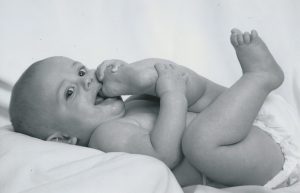 When a baby plays on their back, they will first find the midline of their body bringing their hands together. Midline is a very organizing action for a baby and helps with their coordination. Finding midline helps them explore more and develop more core strength while they gain control to learn to move out of midline. They strengthen their shoulders when they reach up for you or their toys, and their abs will get stronger when they play with their feet. Baby will eventually learn to sit so they can eat safely, begin to play with new toys and challenge their balance skills.
When a baby plays on their back, they will first find the midline of their body bringing their hands together. Midline is a very organizing action for a baby and helps with their coordination. Finding midline helps them explore more and develop more core strength while they gain control to learn to move out of midline. They strengthen their shoulders when they reach up for you or their toys, and their abs will get stronger when they play with their feet. Baby will eventually learn to sit so they can eat safely, begin to play with new toys and challenge their balance skills.
Did you know that the side to side movement that your baby gives themself when they lean side to side ( or when you lean them side to side) will actually help them gain control of their side to side tongue movement? ( That is on the top of my list of the favorite things I have learned from my OT friends!) Makes sense though, right? Have you ever watched someone’s tongue when they play video games?
Anyway….soon they will be ready to start baby boot camp with lots of crawling and climbing for full body strengthening.
Let’s make sure at this early age that your baby is acknowledging both hands and arms equally. This is important for their shoulder motion and their ability to find and reach across midline.

We PTs love crawling (on hands and knees) and prefer them to not skip it! Well, let’s first have gratitude for any way that your baby has learned to crawl. This is great strengthening for the shoulders, abs and hips. The alternating arm and leg movement has good carryover to develop weight shifting and coordination skills, leading to moving in and out of sitting and standing, and then… YES…. walking!!!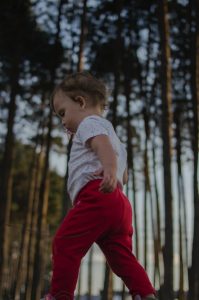
Then watch out- they literally love when life moves to the next level! Your little explorer is on the loose! Lewis and Clarke watch out!
BABY MOVIN’ & FINE MOTOR SKILLS
Your baby’s hands are one of the first things they learn to explore with! This is important- let them! Your baby’s ability to bring their hands together in front of them helps them find their midline of their body. Babies love midline! (And therapist’s love midline!) Finding midline is very important for development! One of the many reasons I love Patty Cake play, moving the arms apart and back together- touching their hands at midline!

They will then move their hands to their mouth- the one part of their body that can give them information at this early stage. Baby’s can use their Grasp reflex to grasp your finger when you place it in their palm. They will also grasp a toy when you place it in their palm, but initially they do not have control of their release and will drop it. Baby’s will start to open and close their hands on a cloth or soft texture if given the opportunity.

Eventually, when given the opportunity to grasp and reach for easy to hold safe toys, they will use their hands and arms equally to hold them longer, mouth them, pass them between hands, shake them, bang them together, etc.
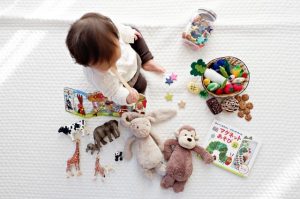 At around 6 months of age, when you baby learns to sit, this will allow their hands to prop on the floor or to be free to play with new sizes and shapes of toys and to play with toys in a new way. Gaining this core and shoulder strength with sitting practice will give your baby more fine motor control for playing, and eventual self-feeding and using utensils.
At around 6 months of age, when you baby learns to sit, this will allow their hands to prop on the floor or to be free to play with new sizes and shapes of toys and to play with toys in a new way. Gaining this core and shoulder strength with sitting practice will give your baby more fine motor control for playing, and eventual self-feeding and using utensils.
BABY MOVIN’ & COGNITIVE SKILLS
 Your baby is very smart! They are developing attention and memory. They use their vision and their eye movements to explore and keep themselves entertained. Remember- eyes are a muscle! I am also not a vision therapist, but I love to learn from them. Basically, though, your baby’s eyes should position equally when they make eye contact with you or a patterned object. They should move together when they are following (“tracking” is the term we use ) an object or a person, as you move in a rainbow pattern over top of them about 12-14 inches away.
Your baby is very smart! They are developing attention and memory. They use their vision and their eye movements to explore and keep themselves entertained. Remember- eyes are a muscle! I am also not a vision therapist, but I love to learn from them. Basically, though, your baby’s eyes should position equally when they make eye contact with you or a patterned object. They should move together when they are following (“tracking” is the term we use ) an object or a person, as you move in a rainbow pattern over top of them about 12-14 inches away.

Typically a baby will turn their head and eyes together when following an object. Your baby’s exploration will soon go beyond their vision once they find their hands to hold them together, mouth them, and look at them. Their exploration will progress when they are given the opportunity to safely explore toys by grasping with their hands and reaching with their arms.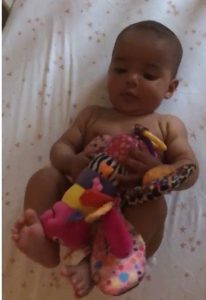
Your baby will then learn to use their hands to find new ways to explore their toys. They will start to mouth them, shake them, and pass them from hand to hand. Your little drummer will also love to start banging their toys on surfaces around 7 months, and then they will start banging things together. They love the new noises they can make! Show them how to do it! Babies are great imitators!
Remember- EXPLORING IS LEARNING!
 Your baby’s memory is first often noticed around feeding time. Many parent’s report that their baby will show anticipation and excitement to eat by changing their breathing rate and by moving their mouth. They can also learn to imitate, especially some basic mouth movements at first, like sticking out their tongue, which can be a great precursor for speech!
Your baby’s memory is first often noticed around feeding time. Many parent’s report that their baby will show anticipation and excitement to eat by changing their breathing rate and by moving their mouth. They can also learn to imitate, especially some basic mouth movements at first, like sticking out their tongue, which can be a great precursor for speech!
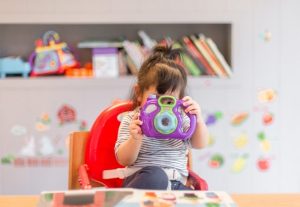 Your baby’s motor skills are also directly related to how they can independently learn from their world. Somehow your baby will get from point A to point B to get to new things and places to explore. At first, they are dependent on you carrying them from place to place ( they are in “station living”, I call it). Once your baby gains the ability to move from point A to point B by rolling, crawling, scooting, or walking…they will usually take this skill and ride with it!
Your baby’s motor skills are also directly related to how they can independently learn from their world. Somehow your baby will get from point A to point B to get to new things and places to explore. At first, they are dependent on you carrying them from place to place ( they are in “station living”, I call it). Once your baby gains the ability to move from point A to point B by rolling, crawling, scooting, or walking…they will usually take this skill and ride with it!
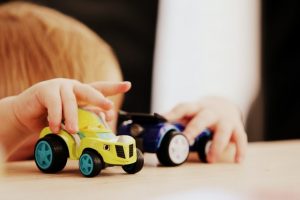
They move around their world and are exposed to new experiences, which builds their memory and their desire to play and explore. They learn to imitate, look at books, play with purpose, and pretend!
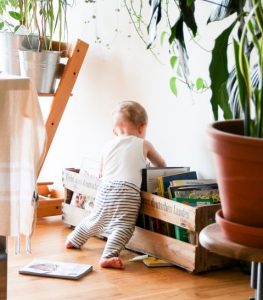 Help Get Your Baby Movin’
Help Get Your Baby Movin’
Remember, your baby is smart and moving can be challenging for some. Babies will often choose the path of least resistance to move, such as butt scooting instead of hands and knee crawling, but nonetheless, they still have somewhere they want to go, and they want to find a way to get there! There is so much to explore and learn from!
Your baby’s motor skills are related to every area of their development. Do you have any concerns about your BABY MOVIN’?
If so, please contact your pediatrician and/or your county’s Early Intervention Agency. Here is the link…..
https://www.cdc.gov/ncbddd/actearly/parents/state-text.html
Check out my blog, “Early Intervention Works!”, to learn more about early intervention and how it can help your child and family.

Playing is their job!
They are working hard- just like you!
